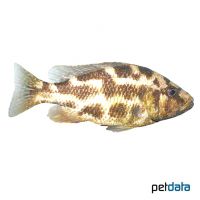Polystigma Cichlid (Nimbochromis polystigma)
| Polystigma Cichlid Nimbochromis polystigma | |
|---|---|
| Name | Polystigma Cichlid |
| Name Lat. | Nimbochromis polystigma |
| Synonym | Haplochromis polystigma |
| Family | Cichlids |
| Family lat. | Cichlidae |
| Order | Cichlids |
| Order lat. | Cichliformes |
| Origin | Lake Malawi |
| Habitat | Sandy intermediate zone |
| Diet | Carnivore |
| pH | 7.5-8.8 |
| Behavior | Aggressive |
| Keeping | Pair, group |
| Care Level | Moderate |
| Reproduction | Mouthbrooder |
| Breeding | Moderately difficult |
| Life Span | 5-8 years |
| Protection | No |
| Metric Units | |
| Size | 18-23 cm |
| Temperature | 24-28 °C |
| Hardness | 10-25 °dH |
| Aquarium | 400 l |
| US Units | |
| Size | 7"-9" |
| Temperature | 75-82 °F |
| Hardness | 178-445 ppm |
| Aquarium | 100 gal |
Distribution and habitat
The many-spotted mouthbrooders occur exclusively (endemically) in Lake Malawi and are widespread throughout the lake. They prefer to live in the shore zone of protected bays with vallisneria and potamogeton fields and sandy-muddy bottoms, but occasionally also in the rocky zone.
Maintenance
The aquarium should have border planting (e.g. Vallisneria, Potamogeton) with large, free sand areas and some boulders (hiding places, visual barriers) as well as plenty of free swimming space. A light colored, deep substrate of sand or fine gravel is ideal.
No ammonia, ammonium and nitrite should be detectable, the nitrate value should not exceed 100 mg/l. To ensure the water quality and oxygen content, a filter and heater adapted to the aquarium size is required, as well as lighting for the species-appropriate day-night rhythm of the animals.
Diet
They are ambush hunters that feed on fish and invertebrates. According to their size, the food offer consists of insect larvae, worms, shrimps and fish, which is accepted without problems also in frozen form, supplemented with commercially available frozen special food mixtures for cichlids. High-quality dry food for cichlids (granules, pellets) is also well accepted
It is recommended to feed small portions several times a day. Regular and varied feeding promotes health and increases resistance. Only as much should be fed as is eaten in a few minutes.
Behaviour and compatibility
They should be maintained in a harem, one male with several females. During the spawning season, males are territorial and aggressive among themselves, but also against females that are not ready to mate. Keeping a harem is only recommended in a much larger and richly structured tank. They are quiet hunters that can be socialized well with other large cichlids. Fish that are too small are considered food
Basically, only compatible fish species with similar demands on water condition and water temperature should be socialized.
Sex dimorphism
The animals differ clearly in coloration (sexual dichromatism). The sexually mature male has a blue colored head and egg spots on the anal fin. The female is smaller and inconspicuous golden-brown spotted.
Reproduction and breeding
They are maternal mouth breeders. The male builds a shallow pit, usually on a large rock or stone, into which the female spawns up to 100 eggs. After fertilization by the male, the female immediately takes the eggs into the throat pouch for mouthbrooding and retains the fry therein even after hatching. After about 3 weeks, the fry are released. During the entire mouthbrood care, the female does not take any food. The fry continue to be cared for by the female for about 10 days and are taken up in the throat pouch in case of danger before brood care ends.
Fry must be fed several times a day with special rearing food (Artemia nauplii). Breeding is hardly possible in a community tank, as the fry are easy prey.
Important
The polychrome brooders have special hunting strategies. As loners, they lie motionless in wait for prey, well camouflaged with their spotted color pattern. In the short term, 20-50 spotted broods also join together to hunt for fish.
The well-being of the fish should be monitored regularly. Temperature should be checked daily, pH, hardness and nitrate levels at least fortnightly. Regular partial water changes are recommended, even if the contaminant level has not yet reached the upper limit. Sudden changes in water quality should be avoided. Newly introduced fish must be accustomed slowly to the water in the aquarium.
Further literature can be found in your pet store.
References
Text: Werner Winter; Image: petdata
Source: BMELV (1998): Tierschutzgutachten - Haltung von Zierfischen (Süßwasser); RIEHL & BAENSCH (2006): Aquarien Atlas Bd. 1, Mergus Verlag; ENGELMANN (2005): Zootierhaltung - Tiere in menschlicher Obhut: Fische, Verlag Harri Deutsch
- Gemäß § 21 Abs. 5 Tierschutzgesetz idgF
